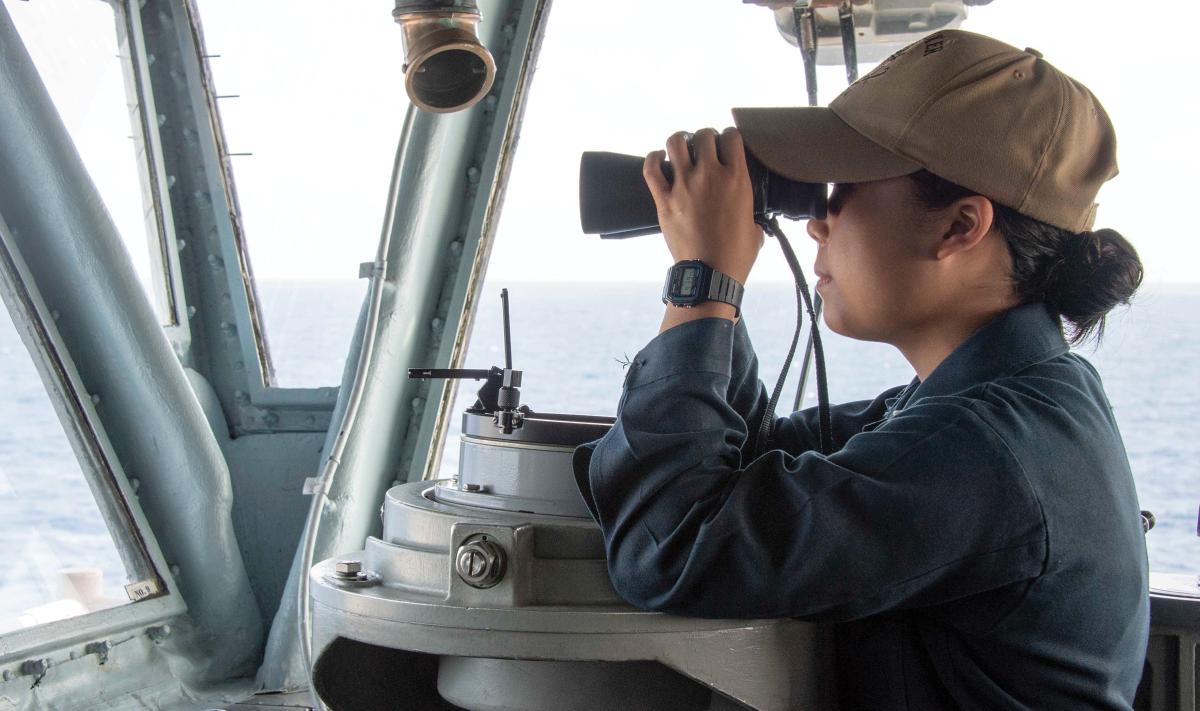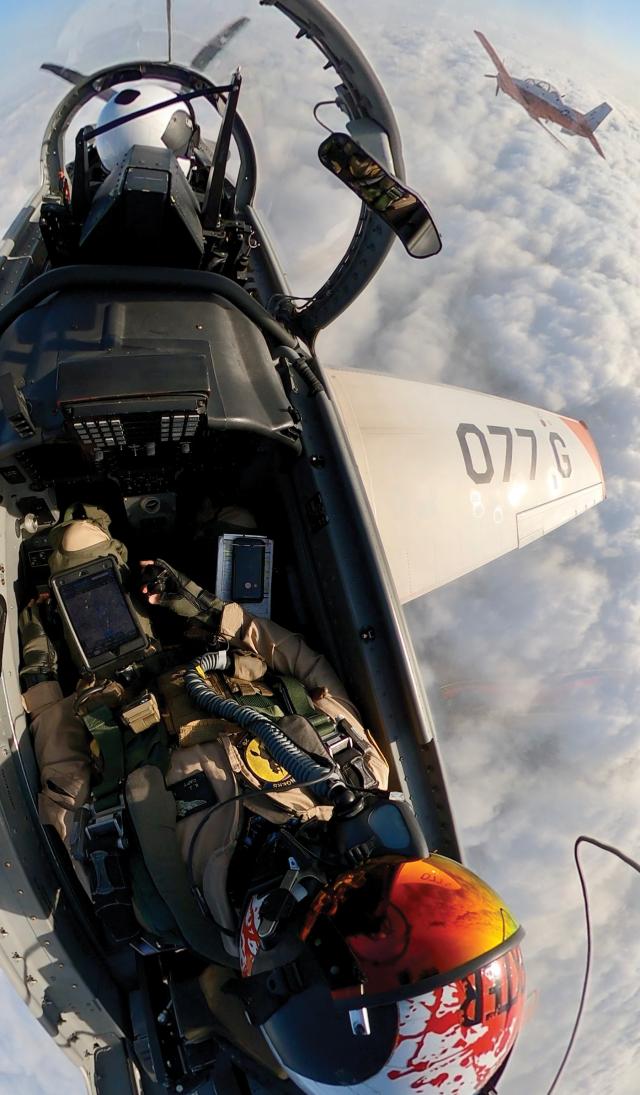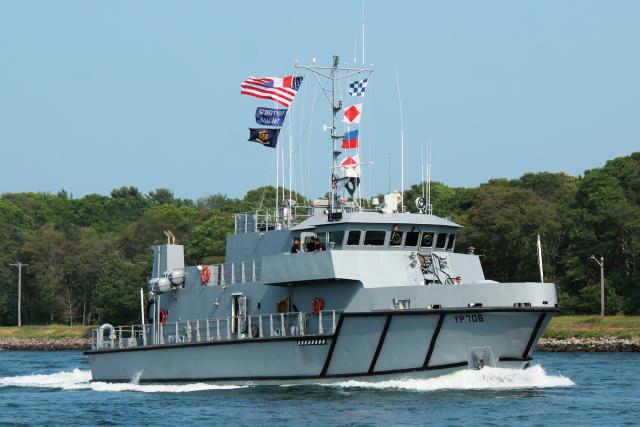In 2020, the Navy invested more than $200 million to establish enhanced shore-based training facilities, including Mariner Skills Training Centers in San Diego and Norfolk, to improve seamanship and navigation proficiency across the surface navy. Each of these facilities will house 30 advanced shiphandling simulators to train individuals and watch teams.1 These are welcome improvements; however, they fail to address a structural problem in how the Navy trains and qualifies new surface warfare officers (SWOs). After a few months of training ashore in classrooms and simulators, partially trained and unqualified officers report to their first ships, where their commanding officers preside over the rest of the training and qualification process.
This model would benefit from adopting training concepts developed in the naval aviation community, where new pilots report to their first operational assignment only after they are qualified and winged.
Shortfalls for Ship Drivers
The surface community has changed how it trains new officers multiple times. Prior to 2003, all new SWOs received six months of training before reporting to a ship. In an effort to save money, in 2003 the Navy implemented a new model relying entirely on computer-based and on-the-job training (OJT). Newly commissioned officers reported directly to their first ships and received a box of five CDs, completing lesson modules on their own time.
Not surprisingly, relying on newly commissioned officers to mostly train themselves was a failure, and the community gradually reintroduced in-person courses for new SWOs beginning around 2009.2 Today, after SWOs commission, they report to the Basic Division Officer Course (BDOC) in either Norfolk or San Diego. At BDOC, they receive nine weeks of classroom training and multiple sessions in a simulator that introduce the fundamentals of ship driving. Afterward, they attend the Junior Officer of the Deck (JOOD) course, where they receive four weeks (increasing to six weeks in 2021) of more rigorous simulator-based navigation and seamanship training.
After the JOOD course, these ensigns report to their first ships and immediately begin serving in various division officer jobs. As new division officers, they lead a division of sailors and are responsible for equipment maintenance, space upkeep, training programs, personnel administration, and other collateral duties. These new responsibilities can be overwhelming and exhausting.
In addition, these new officers stand in-port and at-sea watches, only some of which directly involve driving the ship. It is during these watches that OJT is supposed to occur, where the new officers finally experience driving an actual ship. Over time, the officers must demonstrate to their commanding officers that they have mastered all the skills necessary to qualify as officer of the deck and eventually receive their SWO pins.
This model of training new officers often fails to produce proficient ship drivers for a number of reasons:
Overreliance on Simulators. A large part of mariner training in the BDOC and JOOD course consists of simulator sessions. Although a good simulator plays a valuable role in basic navigation and seamanship training, it cannot fully replicate the unique experience and stresses of driving a real ship.As two members of the surface community put it, “The reality of a stiff breeze, an unexpected current, and the occasional steering or engine failure on a real vessel with real consequences . . . is difficult to duplicate.”3
Differing Ship Experiences. Accession training introduces mariner skills, but additional training and qualification occur through OJT on board a warship. Not all ships provide the same experience, however. For example, one new division officer may report to a ship commencing an extended maintenance period in the shipyard, while another reports to a ship preparing to depart on a seven-month deployment. The second officer has a clear advantage in gaining experience driving a ship. While both officers may ultimately be qualified by their ships’ commanding officers, their levels of proficiency will vary significantly.
Untrained Trainers. Although the system relies on OJT, the officers who will be the instructors receive no training as instructors and tend to be junior officers who have only recently qualified themselves. More experienced officers (the commanding officer, executive officer, department heads) tend to have little time to devote to training and may themselves lack certain proficiencies, as they are products of the same system.
Competing Duties. New division officers juggle many responsibilities that compete for their time and attention, often forcing mariner skills training to take a back seat to more pressing duties.
Fatigue. In addition to their division officer responsibilities, new officers are expected to stand frequent watches at sea and in port. Fatigue quickly builds and can impede meaningful training. In spite of a recent increase in community awareness of this problem, there are no mandated rest requirements within the surface force. Young officers can become burned out before they even qualify.
Low Prioritization. For shipboard leaders, training young officers tends to be a lower priority than the requirement to accomplish operational tasking, complete costly maintenance periods on time, pass key assessments and certifications, etc. This often translates into infrequent and low-quality training for junior officers.
Lack of Standardization. Navy personnel qualification standards outline specific topics and skills that should be mastered by a SWO in training, but there is no external oversight on how this is to be implemented. The result is that how officers are taught to anchor or recover a man overboard may vary from ship to ship. Lack of standardization can produce qualified officers who do things a certain way because that is how they were trained, not necessarily because it is the correct way.
The Aviation Model
Naval aviation produces trained and qualified officers who arrive to the fleet ready to fill assignments in operational squadrons. During training they benefit from a standardized model that incorporates both simulator hours and actual cockpit time.4 The aviation community uses simulation to enhance student learning and as a complement to actual flight hours.
Dedicated training squadrons whose sole mission is to train and qualify new aviators also make a difference. Training future naval aviators is their top priority. Flight instructors assigned to these squadrons are seasoned pilots who, after passing a competitive screening process, receive specialized training as instructors. A standardized training curriculum ensures all student pilots are graded on the same scale and receive the same minimum number of simulator hours and live flights. Throughout flight training, a student has no other duties. They also benefit from mandatory rest requirements that prevent fatigue from decreasing training effectiveness (or adding risk to training flights).
Recommendations
The current qualification process used by the surface navy needs immediate attention. Although driving a ship demands different skills than flying an aircraft, SWO training would improve dramatically if it were restructured based in part on the naval aviation model. Specifically, the surface navy should consider:
Surface Training Squadrons. Establish squadrons in Norfolk and San Diego, staffed by screened and experienced SWOs with no other duties. The Navy should prioritize these billets to ensure students are trained by top-performing officers and provide standardized curriculum and assessment guidelines to ensure a consistent level of quality training and eliminate gaps.
Training Ships. In addition to simulators, acquire dedicated training ships to provide quality, at-sea training in mariner skills. As demonstrated in the aviation community, effective training models incorporate both real-world and simulation-based training. Funding will be a challenge, but not an insurmountable one.5 Several options exist, including:
- Purchase inexpensive, small training vessels similar to the yard patrol training craft used at the Naval Academy.
- Build new training ships such as the National Security Multi-Mission Vessel being purchased by the Maritime Administration to train cadets at State Maritime Academies.6
- Designate existing ships as training units and assign them to the new training squadrons. This could include repurposing older warships for training.
A SWO Qualification Timeline. Require surface warfare officers to complete their initial qualifications, including officer of the deck, during accession training instead of during their first division officer assignment. This would allow SWO candidates to focus on training without competing responsibilities, and also ensure that operational ships and squadrons receive qualified officers able to contribute immediately.
These structural changes would revolutionize SWO training and produce a community of competent, capable mariners. Were the Navy to adopt some aspects of naval aviation’s pilot training model and invest the necessary resources, ships and the entire surface navy would immediately benefit.
1. “Resourcing a Ready Surface Force,” Navy Live, The Official Blog of the U.S. Navy, 6 May 2019, https://navylive.dodlive.mil/2019/05/06/resourcing-a-ready-surface-force/.
2. ADM Phillip M. Balisle, USN, “Final Report: Fleet Review Panel of Surface Force Readiness,” 26 February 2010.
3. CAPT John P. Cordle, USN (Ret.), and LCDR Toy Andrews, USN, “Back to Driving Ships, Part III,” U.S. Naval Institute Proceedings 144, no. 7 (July 2018).
4. In one study, it was flight time that proved to be strongly correlated with naval flight students’ Naval Standard Score. Although this research did not discount the value of simulator training, its author suggests it “may be more effective and efficient in the intermediate phases of pilot learning than in the advanced phases.” Thus, shiphandling simulators in BDOC and the JOOD course appropriately deliver basic and intermediate mariner skills training; what the Navy lacks is complementary at-sea training to build intermediate and advanced ship driving skills. A. D. Judy, “A Study of Flight Simulation Training Time, Aircraft Training Time, and Pilot Competence as Measured by the Naval Standard Score,” doctoral dissertation, Southeastern University College of Education, 2018, https://firescholars.seu.edu/coe/22.
5. Naval aviation requested and received approximately $1.2 billion to purchase and maintain training aircraft over the five years covered by the FY16 through FY20 National Defense Authorization Acts. The submarine community invested more than $600 million in FY17 to repurpose aged submarines as moored training ships at the Naval Nuclear Power Training Unit in Charleston, SC. These investments far exceed what the surface navy spends on training platforms (which, of course, include no actual ships).
6. Craig Hooper, “Damn the Torpedoes! Add Training Ships to the U.S. Navy’s Shopping List,” Forbes, 31 March 2020, www.forbes.com/sites/craighooper/2019/03/21/damn-the-torpedoes-add-training-ships-to-the-u-s-navy-shopping-list/.





